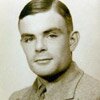visits
317
votes
14
votes++Vote positively this post :)
+31
votes--Vote negatively this post :(
-17
Alan Turing: Biography

The English Alan Mathinson Turing (23/6/1912-7/6/1954), is described by his biographer, Andrew Hodges, as scruffy, stutterer, eccentric, antisocial, autodidact, but overall, as a genius. He liked mathematics and athletics, ignored to anyone that he considered intellectually inferior and looked himself as a kind of machine, but although he had a peculiar personality, more interesting is his work.
To understand his most important contribution, first we must know the incompleteness theorems of Kürt Gödel (scientific contemporary to Turing), which demonstrated that the mathematics was inconsistent from the point of view of the logic. In the mathematics we have a set of rules and a subset of them are axioms (the basic rules that are considered evident and they don't derive from any other). Gödel demonstrated that we can generate rules that we can't determine if are correct or incorrect from the axioms, is that to say, rules that don't have solution. A typical example, inside the field of logic, is the phrase: "This phrase is false", where we can't say if is true or false.
For that the mathematics remain being a consistent science, was needed find a way of define this kind of paradoxical rules using the axioms, or in other words, was needed find a sequence of steps (algorithm) which was capable of identifying what was computable and what it isn't. Turing thought that this steps could be accomplished by a machine and invented the Turing machine, which really is a theoretical computer, where a header reads and writes data in an infinity strip of tape. In this way, he set the basis to build the first computers, and not only that, but also, he demonstrated what problems will can resolve and what problems will can't. One of this problems that demonstrated that it wasn't computable, was identify the arbitrary rules proposed by Gödel using the axioms, demonstrating that the mathematic are inherently inconsistent.
Another contemporary of him, John Von Neumann, read the work of Turing and realized that he was created a new science, so that he proposed to Turing create his machine. Turing rejected his proposition, and nevertheless, Von Neumann, created the ENIAC (the first computer with Von Neumann architecture). Today all the computers follow using that architecture.
In 1939, during the second world war, Turing was obliged to leave his career apart to help in the construction of the calculator Colosuss that decrypted the codes of the Enigma machine that was using the nazis to send encrypted messages. Thanks to this computer of specific purpose, allied troops could know their plans and their locations. Although the nazis was suspecting something, they blamed the spies for the information filtrations, because they thought that the generated messages by Enigma was unbreakable so they followed using it. So, if if were not for Turing, probably they had lost the war.
In his work "Computing machinery and intelligence", published in 1950, Turing said that he could teach to the computers to think by itself and generate original thoughts as we do the human beings. To that this intelligence seemed human, Turing purposed to add random components to the algorithms. Accused of sentimentalists to those that denied the possibility of intelligent machines and treated the philosophical objections as irrelevant topics to achieve this objective. But how we can know if had been achieved create an intelligent machine? For this check proposed put the machine through the Turing test, where a human must find out if they was talking with a human or with a machine without seeing it. Turing estimated that in the year 2000 we could dispose of computer sufficiently powerful to allow deceive the 70% of the persons that made the test during 5 minutes, but today still any chatbot had achieved it.
Turing also studied the morphogenesis (the evolution through the development of patterns in the organism) about it published "The Chemical basis of Morphogenesis", in 1952, Turing wanted know the mathematical process that made evolve the life in complex forms. How was contained in the primordial chemical soup the information that allows develop that complexity? Casually Crick and Watson was trying solve the same problem but from a microbiological perspective and they discovered de ADN. Turing stalled when he found in his differential equations of first order that the complexity was creating to himself.
A weekend, Turing left his boyfriend alone in his house and when he come back, he discovered that he had stole him. Angry denounced it to the police and in the investigation they discovered that they were a couple. In that epoch the homosexuality was punishable by imprisonment or chemical castration and he choose the second. Disgraced publicly, disowned by his family, forced to take drugs that became him impotent, excluded from his creative work with the computers, stalled in his study of the morphogenesis and also having a background of depression and suicide ideas, he decided carry out this idea, biting a poisoned apple with cyanide.
The vice-president of Google and inventor of the TCP/IP, Vinton Cerf, the chess player Garry Kasparov and other personalities, will celebrate a conference from the 22 to the 25 of June of 2012, in the University of Manchester. This university had been chosen to commemorate the first century of the born of Turing, due to that was here where was built, with the help of Turing, the "Manchester Automatic Digital Machine", also known as MADAM, that in 1948 was the first electronic computer that could execute large algorithms, which Turing used to made programs to play chess and wrote love letters, between other things.